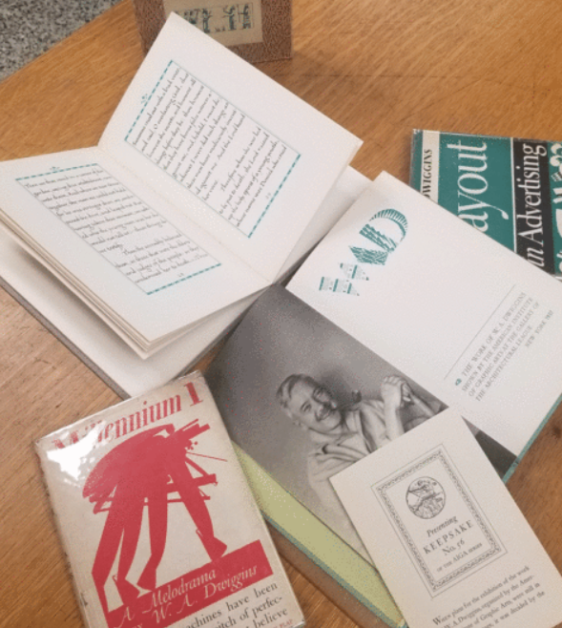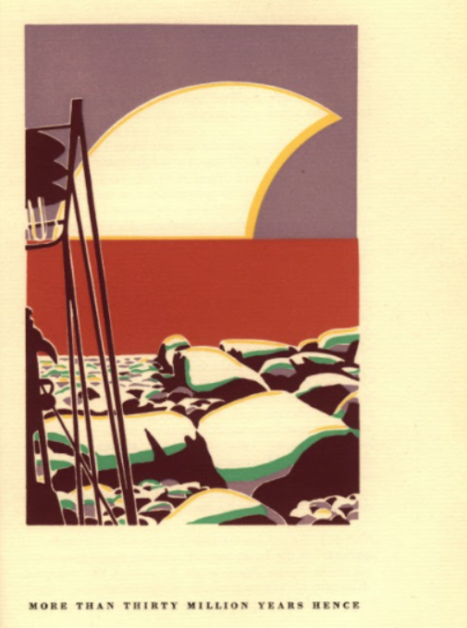The Collector

Michael Hughey’s connection to the Rare Book Collection began under Special Collections Librarian Emilie Mills. Their mutual friendship and her appreciation of his talents as a calligrapher led to the collaboration of his supplying the hand lettering of the covers for the Friends of the Library Annual Report during her tenure. In addition to his contribution on such a small publication, Hughey also ran Twin Dolphin Design, a graphic design and publishing studio, located in Asheville, NC. Among his more widely known contributions were those with Walter Hamady of Perishable Press Limited. Rare Books is fortunate to house those works in the Perishable Press Limited Collection and works from Hughey’s own Twin Dolphin Design in Special Collections.
Hughey’s love of beautiful letters, book design, illustration, and the tactile materials that are part of book construction led him to collect specific books. One such collection is the works of William Addison Dwiggins – a fellow calligrapher. Hughey describes Dwiggins and his contribution to book arts:
“He studied under F.W. Goudy in Chicago at the Frank Holme School of Illustration about 1900 and followed Goudy to Hingham, Mass. when the Village Press was established. With a studio in Boston and work for D. B. Updike at the Merrymount Press, Dwiggins emerged in the mid-1920s as a book designer. He began his association with Alfred A. Knopf in 1926 and over the next thirty years was the most prolific of all book designers for A. A. Knopf, Inc. He developed an unconventional individual style of ornament. WAD, as he frequently signed his illustrations and designs, was calligrapher, illustrator, decorator, book-designer, book jacket-designer, and type-designer, a man of unique talents.”
The Collection
Hughey’s collection of Dwiggins’ output consists of over a hundred titles as well as promotional samples of his work. Dwiggins’ Layout in Advertising (1928) and the revised edition, both pivotal works in the development of graphic design, are included. Other works, such as Millennium I (1945) and The Power of Print – and Men, with Thomas Dreier (1936) add to our book arts holdings. Dwiggins’ influence in the development of typefaces in the early to mid-20th century, illustration, and support of calligraphy in the face of a highly mechanized book production methods did not go unrecognized. During his lifetime, the American Institute of Graphic Arts recognized him with an exhibition and book, The Work of W.A. Dwiggins (1937). Because of his long affiliation with Knopf as well as other publishers, this collection expands our holdings of the works by Willa Cather, Robert Nathan, and H.G. Wells.

Dwiggins’ edition of H.G. Wells’ The Time Machine: An Invention (1931) includes a new preface by Wells, specifically for this edition. This work, originally published in 1895 and is an early example of science fiction, has the following premise: The protagonist discovers that Time is a fourth dimension and builds a model in which he can explore it – what will he find? Dwiggins’ illustrations provide a refreshed perspective on the futuristic visions of the author. Through his use of line, color, spacing, and typeface, Dwiggins’ hand influences many of the design choices book artists continue to make today. Bookbuilders of Boston, founded in 1937, renamed its highest award the Dwiggins Award:
The Dwiggins Award honors the exceptional contribution of one person out of a community of highly skilled and active people. It is awarded to someone who exemplifies the ideals of Bookbuilders; has the highest personal standards of craftsmanship and devotion to his/her work; has demonstrated an interest in and service to the bookbuilding community; has given “something extra” to his/her job or to Bookbuilders in terms of talent, brilliance, integrity, devotion, or helpfulness to others; and compares favorably with previous Dwiggins Award recipients.
Were Dwiggins to have use of Wells’ Time Machine, one wonders what he would think of how book arts have progressed. Hughey’s collection of Dwiggins’ works provides greater access to those innovative and influential examples.